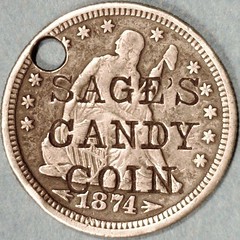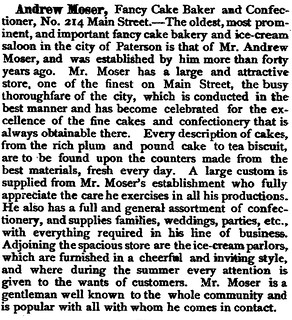
PREV ARTICLE
NEXT ARTICLE
FULL ISSUE
PREV FULL ISSUE
SAGE'S CANDY COIN COUNTERSTAMPBill Groom submitted this original article about the popular SAGE'S CANDY COIN counterstamp. Thanks! -Editor Finally... A Most Likely Attribution! by Bill Groom 
Dr, Brunk noted that all known host coins bearing Sage's mark were dated 1874 and designated this issue as # S-86. Since 2003, Brunk's recorded more host coins as follows: 23 quarters, 18 half dollars and 6 Trade Dollars. Likely, more specimens have surfaced in the past few years, bringing the total to a possible fifty or more pieces. Note that all known host coins are of "prized" silver content. Dr. Brunk noted that a search of periodicals for that year, 1874, might lead to the identity and whereabouts of the elusive Mr. Sage. It seems that Dr. Brunk was correct about the periodical source. To the right is a newspaper article that this writer found in the City & Suburban News of Paterson, NJ, dated February 26, 1875 ... Judging from contemporary newspaper articles, Sage drew impressive crowds and some folks won gold and silver coins in their candy containers. However, Sage's presence in Paterson was short-lived ...
It's noteworthy that all of the SAGE'S CANDY COIN counterstamps are hosted upon coins dated 1874. This year coincides with the time, early 1875, during which the mysterious Mr. Sage was active in Paterson. The silver coins would then have been in virtual mint condition, new and shiny. If "Sage" was this huckster's true name, this writer has as yet found no further mention of him elsewhere. There are numerous newspaper articles about similar hucksters operating in many locations like Philadelphia, New York City, Chicago, etc. Possibly, Mr. "Sage" used other names? In addition to "Sage" suggesting a person of wise and prudent judgment, there were some well known contemporaries, Augustus and Russell Sage. Then too, there was the much advertised "Dr. Sage" (a pseudonym) who marketed patent medicine. By and large, these candy lotteries often proved unpopular, and legal action typically ensued. Thus, their tenure in one location was often short yet sweet (pun intended). Thanks to the research of Bruce Mosher, my counterstamp compadre in New Jersey, it was learned that there were no directory listings for anyone named Sage in the Paterson area; this, between 1873-1876. Interestingly, Bruce learned that there was a confectioner, named Andrew Moser, conveniently located next door to Sage's operation at 216 Main Street. Bruce and I were unable to determine if Moser, at 214 Main Street, had a working or other relationship with Sage; but, may have been his landlord. It's quite possible that it was Moser who supplied Sage with the candy. Moser was then a long-established businessman in Paterson. Surely, even an implied relationship with such a well known citizen such as Moser would have given Sage an air of respectability. Below is given some information on Andrew Moser. Perhaps, a future researcher will be able to connect Moser with the mysterious Mr. Sage? Part VI. INDUSTRIES Of NEW JERSEY. HUDSON, PASSAIC, AND BERGEN COUNTIES (1883)  To summarize, Bruce and I agree that these "Sage" counterstamps were among coin prizes that were randomly distributed in packages of candy at 216 Main Street in Paterson, N.J.; this, between February and March of 1875. Mr. Sage was not a local man, and that may not have been his true name. These schemes were commonplace in the mid to late 1800's. In some cases, the lottery hucksters were prosecuted and jailed. In light of this, and in order to avoid running afoul of the law, it makes sense that Mr. Sage "took a powder" and hastily left Paterson; this, inside of three weeks. As no later dated coins with the Sage counterstamp are known, he evidently did not continue his lottery scheme ... at least so, by using the name, Sage! In time, perhaps more light can be shed upon this mystery man. N.B. - In 2017, I penned an article for NTCA on the "Professor King" tokens, entitled "PUNCHLINES: A Pair of Prestidigitators (Part II)." These may well date to the Civil War era. Like Sage, Professor King (a pseudonym?) operated a lottery scheme in central New York. He "disappeared" pursuant to a legal judgment against him. I'm not proposing that he was also Mr. Sage - just maybe! 
Wayne Homren, Editor The Numismatic Bibliomania Society is a non-profit organization promoting numismatic literature. See our web site at coinbooks.org. To submit items for publication in The E-Sylum, write to the Editor at this address: whomren@gmail.com To subscribe go to: https://my.binhost.com/lists/listinfo/esylum All Rights Reserved. NBS Home Page Contact the NBS webmaster 
|




